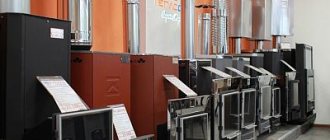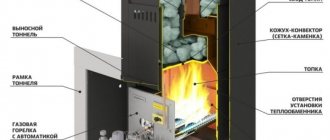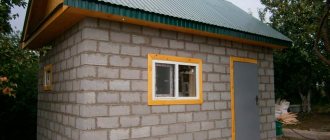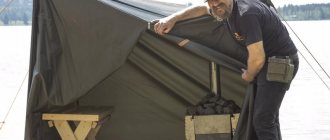And so, important criteria when choosing a stove for a bath:
Furnace power.
The most important thing you need to consider when choosing a stove for a sauna is that the power should be optimal. You can buy a stove made of steel, cast iron, wood, gas, electric, cheap or expensive, any criterion can apply, except for one thing - it must correspond in power to your steam room. The issue of heater power can be neglected only in one case: if you have built a hammam, where there is no sauna stove in the usual sense. Incorrectly chosen power will lead to unpleasant consequences, which we will consider further.
Excess power.
It happens that people want their steam room to warm up faster. In this case, they purchase a stove with a large power reserve; yes, the steam room will warm up faster in this case, but this is only at the beginning. Then the oven will work at the minimum of its capabilities. This is a welcome sign that your steam room will be filled with hot air, but the stones will remain cold, on which it is useless to pour water - there will be no steam from them, and if there is, it will be in clouds and white, like when a kettle is boiling, and not that light and transparent as you expected.
Lack of power.
A completely different extreme is to purchase a stove with minimal power just to save money. Of course, the stove will be able to heat the steam room to the required temperature. But it will have to work to the limit, in this mode the stove will not serve you for long and will entail replacing the stove, spending time and money on dismantling and installation. Ultimately, running your oven to its limits is simply not safe.
Calculation of the optimal power of a sauna stove.
Now the next question: what is the optimal power? All manufacturers indicate for each model not only the power in kilowatts, but also the recommended steam room volume. To make the calculations easier, we will not delve into the details, and we will take the cubic capacity of the steam room as a basis. It's much easier to count this way.
Determining the cubic capacity of the steam room
If you built your bathhouse according to a project, then you will not have problems determining its volume - it is in the project. If there is no project, then you will have to work with a tape measure. We measure the steam room, write down the results, multiply them together and you get the volume of your steam room. It would seem that the volume has been obtained, and you need to select a sauna stove for it, but no, there are a number of nuances that need to be taken into account. If you have uninsulated areas in your steam room, for example, brickwork, stone cladding, windows... then you need to calculate the area of these areas. Then multiply by 1.2 and add to the cubic capacity obtained earlier. If you have a glass door installed in your steam room, then add another 1.5 m3 to the resulting volume. If your steam room is made without interior decoration, then multiply the volume by 1.5.
Example: let's say we have a steam room with dimensions of 2.5x2x1.5 meters. Then, under ideal conditions, its volume will be: 2.5 * 2 * 1.5, which is equal to 7.5 m3. If a glass door is installed in the steam room, then add another 1.5 m3 to the resulting volume and get 16.5 m3. If there is no finishing in the steam room, we multiply the resulting volume by 1.5, resulting in 22.5 m3 - the cubic capacity of the steam room without finishing, therefore, you need to select the stove for this volume. If you do not want to do the calculations yourself, then you can always contact our specialists.
Now you know the volume for which the sauna stove you need should be designed. And don't forget about the stones. To fully utilize the heater’s thermal power, you should load it with as many stones as the manufacturer recommends. This parameter is also indicated for each model.
Furnace material.
It is no secret that the quality of the stove material is an indicator of how long the stove will serve you. Nowadays, the leading positions on the market are occupied by stoves made of steel and cast iron. But which material is better? Steel or cast iron? Let's figure it out.
Principle of operation
And the operation of these devices is no different from their analogues. The oven consists of several main parts:
- furnace body;
- separate compartment for burning wood;
- an ash pan, which is located in the lower part of the stove and serves to collect ash and as a blower to increase draft during the initial ignition of wood;
- grate. It is installed above the ash pan and serves to protect the furnace body from exposure to high temperatures and unhindered pouring of ash into a container for collecting it;
- a screen that is installed in some models and is designed to prevent the direct passage of heat into the chimney. Heat is reflected from the screen, passes through the inside of the stove and only then enters the upper compartment and passes to the chimney, heating the stones;
- exhaust gases exit into the chimney pipe and are released into the atmosphere;
- On top of the furnace body there is a grid for laying stones. When wood burns, the stones heat up. Anyone can raise the temperature in the steam room by splashing several ladlefuls of aromatic infusion or water on the heater.
Rubble concrete foundation
Foundation for the stove.
The formwork must be installed on the base. A layer of large stones is placed in it. The resulting cavities are filled with crushed stone. Then the stone and crushed stone are filled with cement-sand mortar.
Mix the solution as follows: 1 part cement M 400-500 to 3 parts sand. The solution should be thick, like sour cream. They need to pour the first row of stone and take a break for a day, then lay the next row, which is then poured with mortar.
If the volume is small, then you can make a certain amount of concrete and complete the work in one day. After about a week, the foundation is ready for laying.
Advantages and disadvantages
Let us note right away that such stoves have no disadvantages. It can be emphasized that they are made of metal, but by covering such a stove with bricks or covering it with screens, you can not only protect people from burns, but also increase the productivity of the stove. The main thing when buying is to pay attention to the thickness of the metal and the quality of its processing and welding.
Among the advantages, a number of points can be highlighted:
- The furnace body is made taking into account the calculation of the geometry of the firebox surfaces. It is customary to make it round, in this case the level of heat transfer when burning wood increases and the efficiency increases;
- Manufacturers use heat-resistant steels in the manufacture of heaters;
- due to its small dimensions, the mini heater can be installed in any sauna, even a miniature one;
- industrial designs are made taking into account fire safety requirements;
- Carbon monoxide poisoning is excluded if used correctly.
Before purchasing, it is first important to choose a model that is suitable for your premises in terms of power. An approximate calculation of this value will not be difficult to perform if you have all the sizes of the bath and a calculator.
Finishing the room
Treat surfaces with linseed oil, special antiseptics and wax.
Sanded lumber is used in finishing the floors, walls, and in the construction of benches, so after installation it is enough to go over it with sandpaper. This is how to remove raised fibers that appeared during the process of working with wood. For finishing, compositions are used to add attractiveness and emphasize design elements.
Purchase natural-based products for treating wooden floors, walls, and benches. Painting is carried out with the steam room not working so that the products dry under natural conditions. Synthetic dyes and varnishes are not used for the steam room, as they release harmful substances.
Treat surfaces with linseed oil, special antiseptics and wax. Sometimes oil and wax are combined for better impregnation. Wait at least 12 hours between applying several layers to allow the product to absorb and dry.
How to choose?
First you need to figure out the power of the steam room stove.
As an example, we take the dimensions of the bath:
- width – 2 m;
- height – 2.2 m;
- length 3 m.
In this case, the total area is calculated by multiplying the length and width of the room. In our case, it is equal to 6m2. But volume is important to us to calculate power. Therefore, you will need to multiply the area by the height of the walls - 6 * 2.2 = 13.2 m3.
Now it is important to calculate possible heat loss . To do this, having determined the total area of windows and doors, we multiply this value by 1.2. Our steam room has one stove and a window in the dressing room. Therefore, we take heat loss equal to 2.3 m3. We add up the total volume and the volume of losses - 15.3 m3.
Next, you need to determine the power taking into account the level of heat absorption. For calculation purposes, we assume that our bathhouse is made of wooden logs. In this case, we multiply the resulting volume and the coefficient; for log walls it is equal to 1.6. 15.3*1.6=24.48. We round up and find that for our steam room made of logs with one door and window, you will need to purchase a stove with a capacity of 25 kW .
This is an approximate and rough calculation. When choosing a stove for a sauna, you need to pay attention to several more factors.
In addition to power, when choosing a mini-oven, it is important to pay attention to several more factors;
- Type of fuel burned. Domestic and foreign manufacturers produce stoves for small baths that run on different types of fuel. The most expensive ones to operate are electric heaters. Even stoves that run on diesel fuel or coal have been developed. But for Russian lovers of steam and brooms, wood-burning stoves remain the most popular.
- You should pay attention to the design of the combustion chamber. You can purchase a design with the ability to move the firebox to a separate room. For mini baths, this is the best option, but it will require large expenses when purchasing. But this option has one undeniable advantage - you don’t need to litter and stack firewood in the steam room.
- Find out the type of backfill and the device of the heater. They can be closed or open. Of course, open heaters are most in demand among conservatives, but it is closed compartments with stones that are gaining popularity.
When choosing small stoves for a bath, pay attention to several models presented in our TOP on pechnoy.guru.
Options for the internal layout of a 4x5 m bath: the best projects
The procedure for designing such elements as the foundation, wall construction material, roof characteristics, etc. determined by the characteristics of a particular situation and remains primarily at the discretion of the owner. You are also invited to familiarize yourself with the most popular and successful options for internal planning of the space of a 4x5 m bathhouse with separate steam room and wash room.
The simplest design of a 4x5 m bathhouse
The so-called “minimum set”.
The simplest design of a 4x5 m bathhouse
The bathhouse consists of one floor and has dimensions of 4x5 m. There is no vestibule/dressing room, which makes the use of such a bathhouse possible only in warm weather (the reasons were described earlier). The entrance to the building leads to a fairly spacious recreation room measuring 2.85 x 4 m. It is proposed to install a table and a corner sofa or benches here. If desired, the room can be equipped with a TV and related equipment. From the rest room you can get into a wash room measuring 1.8 x 2 m, equipped with a shower, toilet and sink. The door from the washing room leads to a steam room measuring 2x2.1 m with a stove occupying 1 m2.
Project of a 4x5 m bathhouse with a terrace
The set of interior spaces remains similar to the previous version, but a quite spacious terrace appears. The proposed dimensions are 1.5 x 4 m. If desired, the terrace can be glazed to create a veranda. Often, an additional seating area is organized on the terraces/verandas, or even a barbecue oven is installed, if free space allows.
Project of a 4x5 m bathhouse with a terrace
The entrance from the terrace leads to a recreation room measuring 2x3.5 m. Recommendations for equipping this room are similar to the previous and all subsequent projects. The internal door from the relaxation room leads to the shower room (1.5x2 m), and from there to the steam room (2x2 m). Thus, even the presence of a terrace made it possible to correctly fit all the necessary premises into the available space.
Bathhouse 4x5 m with dressing room
In this project, a small dressing room with dimensions of 1.1 x 1.7 m appears. The presence of this room will allow you to comfortably operate the bathhouse in cold weather. It is also proposed to store firewood here.
Bathhouse 4x5 m with dressing room
The exit from the dressing room leads to a small corridor, and from there to the rest room. The latter is connected by a door to the washing compartment, and it is connected to the steam room. Recommendations regarding the dimensions and internal arrangement of each room are given in the diagram. You can take it as a basis, changing the necessary parameters at your discretion, or implement an identical project - the finished bathhouse, despite its relatively modest dimensions, will be very convenient.
Bathhouse 4x5 m, complemented by a vestibule and a bathroom
In this project, in addition to the main premises, there was a vestibule and a bathroom separated from the washing room, which is very convenient.
Bathhouse, complete with vestibule and toilet
The door from the vestibule leads to the rest room, from where you can go to the bathroom or washroom. The washing room is connected by a door to the steam room. The project is one of the most successful and popular.
Bathhouse 4x5 m with porch and attic floor
The presence of an attic tier allows you to use the space of the construction site with maximum benefit and efficiency.
Bathhouse 4x5 m with porch and attic floor
Additionally, it is recommended that the building be equipped with a porch measuring 1.5 x 2.5 m. If desired, instead of a porch, you can make a vestibule, which will allow you to use the bathhouse throughout the year. It is proposed to equip a bedroom on the attic floor. If desired, the space can be divided into a place for sleeping and a relaxation room, or you can make a billiard room here.
Review of the best models
| Model name | Description | Advantages | Price |
| Russian mini-stove “Anyutka” | Installed for servicing premises with a volume of up to 10 m3. Made from mild structural steel. Equipped with a convection casing, which ensures uniform and fast heating of the steam room. With minimal dimensions, it can accommodate 25 kg of stones in the compartment | The minimum dimensions allow installation anywhere in a small steam room. Provides comfortable conditions. The design is reliable and easy to maintain. The chimney is located in the center of the stove. | Average price 8000 rub. |
| Mini-heater “Sudarushka MK” | Made in Russia. Provides comfort in a steam room up to 18 m3. One year warranty. Dimensions: · height -95.7 cm; · width – 59.5 cm; · depth – 96.5 cm. Made of cast iron. Weight 140 kg. | Up to 100 kg of stones can be placed in the net. This allows you to additionally accumulate heat and heat the steam room for a long time with minimal use of firewood. | Over 3700 rub. |
| Model "Kutkin Premium 1.0 | Steam room up to 12 m3, country of origin: Russia. The height of the oven is 90 cm, with a width and depth of 45 cm and 46 cm, respectively. The material of the combustion chamber is stainless steel. Closed heater with up to 50 kg of stones. Time to reach a comfortable temperature is up to 2 hours. | This is one of the inexpensive brands with a combination of price and quality. Available with 3 types of cladding for the outer surfaces of the body. If desired, the stoves can be converted to use gas heaters. | Minimum price – 39,000 rub. |
| "Heat - Extra 400" | Steam room up to 12 m3. The firebox is made of structural metal, 6 mm thick. 12 month warranty. Weight 40 kg. with dimensions: · height – 640 mm; · depth – 530 mm; width -400 mm. The minimum weight of the stone is 60 kg. Possibility of removing the firebox to the dressing room. | This is an inexpensive, but convenient and productive stove, which allows you to further save space in a small steam room when moving the combustion chamber to the dressing room. | Average price 8000 rub. |
| The next three stoves differ only in characteristics and price; each of them has the same advantages. "Vulcan - Mini 15" | The weight of the stove is 90 kg. the weight of the stone in the net is 120 kg. Serves rooms up to 15 m3. Warranty service life – 5 years. The length of the firewood used is 550 mm, with the volume of the combustion chamber being 85 hundredths of m3. End of form | High level of efficiency. The body is made of alloy steel, so the stove will last for several decades. Can be installed outdoors, in a dressing room. The stainless steel water tank can be installed in various places of the oven; special fastenings are equipped for this. The grate is made of cast iron. The time required to warm up the steam room is within an hour. | Average price 16,000 rub. |
| "Granite - Mini" | Weight – 87 kg. Body metal – steel 09G2S. The firebox with a volume of 72 hundredths of a cube can accommodate firewood with a length of 490 mm. The mesh of the heater can hold 70 kg of stone. The cubic capacity of the steam room is up to 15 cubic meters. Warranty period – 5 years End of form | Average price from 16,200 rub. | |
| Oven “Magic – Mini” | Weight 80 kg. Alloy steel. The volume of the firebox is 86 hundredths of a cube and can accommodate firewood 550 mm long. The weight of the stones is 70 kg. 5 year warranty. | From 14800 RUR |
What is a heater
In the minds of untrained people, a heater stove is a heating structure built of stone. In their opinion, this follows from the name itself. However, this idea is erroneous and has nothing to do with reality.
A heater stove is the collective name for all stoves used in a bathhouse and equipped with the same structural element - a heater. It is this detail that determines whether the stove belongs to the group under consideration. At the same time, the design itself, the type of fuel and other features of the heating structure do not matter in this case.
A heater is an element of a stove, a kind of thermal energy accumulator. It is a pile of stones placed in a special open or closed compartment. The mass of stones is large enough to radiate thermal energy into the room for some time after the completion of the kindling.
When the stove is lit, the stones heat up and accumulate thermal energy. The greater the mass of stones, the longer the heating, but the heat reserve will be much higher.
Another task of the heater is steam generation. It is on the stones that they throw water from the ladle when they want to add steam. For some models, this method allows you to protect the case from sudden cooling and cracking. For example, metal stoves without a heater cannot be used to supply steam, only as heating elements.
Design Features
A sauna heater is a regular stove, to which is attached a special compartment with stones placed in it. Typically, river or sea pebbles are used, as well as medium-sized fragments (5-7 cm). Not only do they have enough mass to store heat, but they can also be laid quite tightly and without too many voids between individual stones.
In addition to size, the type of stone backfill plays an important role. As a rule, they use rocks available near the location of the bathhouse.
However, experts prefer to use certain rocks as a filler - it is believed that each type of stone has its own properties and can change the quality of bath procedures.
The stone compartment can be a kind of basket made of a steel strip mounted on the side or on top of the firebox. The location of the heater is determined by the overall design of the stove - if there is a water tank, the heater is installed on the side, and if there is none, on top, above the firebox.
It is noteworthy that there are also reverse options, when the tank is on the side and the heater is on top.
The design of the heater is very simple and does not contain any mechanical parts. It is not difficult to assemble it yourself. The main task will be to select suitable stones and correctly place them close to the wall or top of the firebox.
If the furnace itself is metal, it is necessary to install a cutoff - a steel sheet laid between the hot body and the stones. It will protect the furnace from sudden cooling and possible destruction. On brick stoves, the heater compartment is an element of the masonry and is built together with the main structure.
Where and how to put it correctly?
Depending on the material of the walls, ceiling, and floor in the bathhouse, it is recommended to maintain certain minimum distances from them to the stove. These numbers are the same for all types and sizes of sauna stoves:
- if the floor in the bathhouse is made of wood, you need to make a simple foundation of bricks, laying them out in 1 row, with dimensions larger than the dimensions of the heater by at least 500 mm;
- distance from the floor to the bottom of the stove – 140 mm;
- the distance to the wooden ceiling from the top of the heater is at least 1 m;
- to an unprotected wooden wall, the gap should be 1 m;
- walls protected by panels made of non-combustible thermal insulation materials - a gap of at least 380 mm;
- the walls in the bathhouse are lined with bricks around the stove or if the stove is lined with bricks and the walls are covered with protective screens - a distance of 130 mm.
Before installing the stove, be sure to do a test run of the heater outdoors. In this case, the first stack of firewood in the bathhouse will not cause a lot of smoke from burnt-out residues of oil and other materials.
After this, you can install a mini-oven and connect a ventilation system to it. If you want to maintain the performance of the stove while reducing the amount of firewood, you can select a segment in the damper and almost completely block the access of air to the firebox. Now the firewood will gradually smolder, and the savings in firewood will become evident after the first use.
The chimney is discharged through the roof or wall and covered with a protective screen. The pipes must be secured with clamps, and the passages through the ceilings and roof must be reliably insulated from heat loss and water penetration.
Distinctive parameters of the Russian bath
Externally, a modern Russian bathhouse may look different, but there is something that has remained an unchanged tradition - the special microclimate of the bathhouse:
- air temperature within 60-65 degrees. Celsius. Definitely no more than 70oC!
- humidity within 50-60%.
- finely dispersed steam - this is the kind of steam that is formed under the ceiling of the bathhouse (it is also called “steam cake”).
Of course, if the stove provides the characteristics of creating such a microclimate, then such a stove is suitable for a Russian bath.
If we translate these parameters into ordinary sensations, then in Rus' it was called “light steam”. We think you've heard this expression...
“Light steam” is obtained in a bath with the following indicators: air temperature 60-70oC, humidity - 50-60%. Everything that goes beyond these limits is called a “sauna” or “hamam”.
So, there is an opinion that no other material other than stone heated by fire can create the conditions for the formation of the so-called “light steam” for which Russian baths are famous. It is the light steam that gives rise to sayings in the style: “The day you steam, the day you don’t grow old...”. In our folklore, accurate and apt observations related to the bathhouse have survived through the centuries, and from them you can immediately find out which bathhouse we are talking about.
Compare the parameters of “light steam” with other options for baths and saunas:
Figure 2. Temperature and humidity parameters for different types of baths and saunas
Features of operation
The operation of such ovens is simple. Having laid the firewood, place some thin wood chips near the door for kindling. Now open the slide valve completely and open the ash pan slightly and light the wood. The firebox door must always be kept closed. After the firewood has ignited, the ash pan drawer is completely closed and the air damper is closed.
All that remains is to wait for the steam room to warm up and enjoy the fragrant steam. Do not use damp firewood; the humidity level is at least 20-30%.
You should not burn resinous fuel; in this case, the chimney will have to be cleaned more often than once a month. At the first symptoms of deterioration in draft, immediately repair the breakdown or clean the ventilation pipes.










